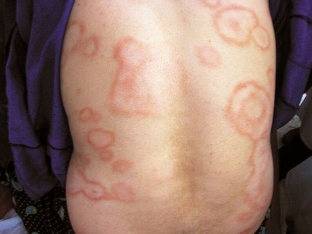During the day, each person at least several times looks at his image in the mirror. Quite often, our attention is drawn to some skin changes: rashes, redness, swelling or other symptoms. All of them signal certain changes in the body, and quite often they are the first reason to visit a specialist. Dermatologists in their practice quite often face such a problem as the appearance of annular erythema on the skin. Read about modern methods of diagnosis and treatment of erythema annulare on estet-portal.com in today's article.
Important considerations when prescribing treatment for erythema annulare
Annular erythema, in most cases, is not an independent disease, but only signals the development of a serious pathological process in the body. The cause of its occurrence may be autoimmune processes, malignant neoplasms, helminthic invasions and some other diseases.
Treatment of erythema annulare implies, first of all, the elimination of the underlying pathology that provoked the appearance of red rings on the skin.
That is why it is so important to conduct the necessary diagnostic tests, establish the correct diagnosis, and only then prescribe treatment.
Erythema annulare treatment:
- diagnostic tests for erythema annulare;
- treatment of erythema annulare: topical agents;
- Treatment of erythema annulare: systemic drugs.
Diagnostic tests for erythema annulare
The diagnostic process for the appearance of erythema annulare on the skin begins with laboratory tests: a general and biochemical blood test, as well as a urine test. Depending on the results of these tests, the following diseases can be suspected:
- slight anemia, accelerated ESR and eosinophilia suggest helminthic invasion;
- an increased level of immunoglobulin E in plasma indicates an allergic reaction;
- decrease in hemoglobin and erythrocytes, changes in the leukocyte formula and acceleration of ESR may indicate the presence of a malignant process.
In addition, additional tests such as serological tests, ultrasound, MRI, CT, and others may be performed. For example, Lyme disease confirms the presence of in the blood serum of immunoglobulins M and G to Borrelia.

Treatment of erythema annulare: topical agents
Treatment for erythema annulare depends on the underlying condition causing the red rings to appear on the skin. Preparations for local and systemic therapy can be used. Topical treatment includes:
- Antihistamines in the form of creams, gels and ointments that relieve swelling, skin itch and redness associated with the release of histamine. Their appointment takes place in the allergic nature of the disease;
- ointments containing zinc compounds that eliminate inflammation in the epidermis and dermis, as well as relieve itching and flaking of the skin;
- topical preparations with glucocorticosteroids that reduce the activity and reproduction of T-lymphocytes, thus eliminating the main cause of local changes in the skin.
Treatment of erythema annulare: systemic drugs
Systemic drugs may also be used to treat erythema annulare, as needed in these cases:
- desensitizing agents remove toxins and allergens from the blood, as well as reduce the permeability of the vascular wall and stabilize the membranes of immune cells;
- are prescribed for rheumatic diseases and other autoimmune pathologies; antibacterial agents are necessary for the infectious nature of the pathology;
- if there is a helminthic invasion, antihelminthic drugs are prescribed;
- cytostatics eliminate the manifestations of autoimmune processes.
However, a correctly performed diagnosis and a well-designed treatment regimen will help to effectively eliminate the pathology. estet-portal.com thanks you for your attention.
You may also be interested in:
"Erythema nodosum: why diagnosing the underlying disease is important"






Add a comment